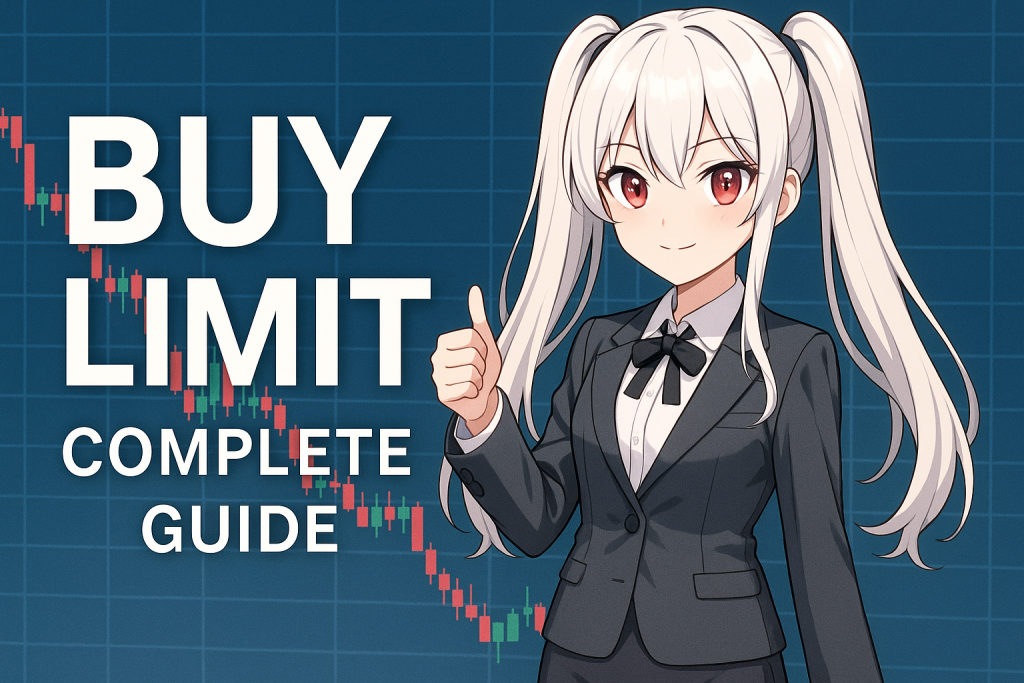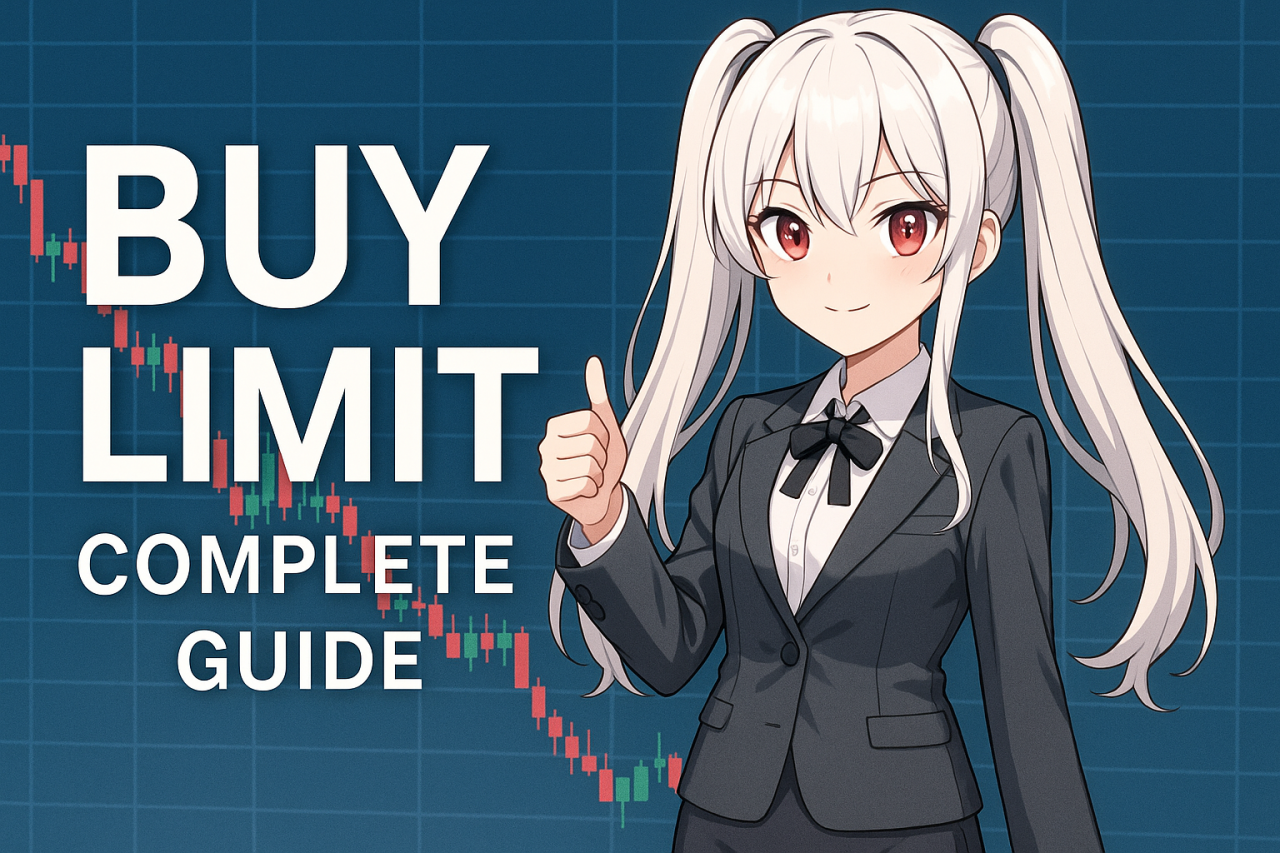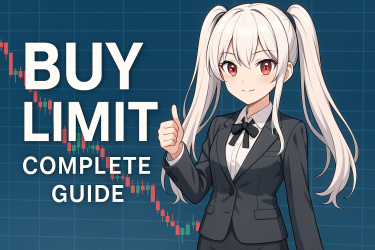- 1 What is Buy Limit? Understanding the Basics
- 2 Difference Between Limit Orders and Stop Orders
- 3 Buy Limit Order Pros and Cons
- 4 How to set a Buy Limit in MT5 (MetaTrader 5)
- 5 FX Trading Strategy Using Buy Limit
- 6 Buy Limit Usage: Precautions and Risk Management
- 7 Summary: Master Buy Limit to Gain an Advantage in FX Trading
- 8 Reference Links
What is Buy Limit? Understanding the Basics
Definition of Buy Limit and Its Role in FX Trading
Buy Limit (Buy Limit) is an order method to place a buy order at a price lower than the current market price. It is used when investors want to hold a buy position at a specific price.
Buy Limit orders can be set to automatically execute when the price falls and reaches the specified price.
In FX trading, Buy Limit orders play an important role as a strategic tool. By setting Buy Limit orders based on expected support levels and past price trends, you may be able to acquire positions at more favorable prices.
Additionally, Buy Limit orders help avoid emotional trading and support planned trading. Investors can maintain calm judgment without being swayed by market fluctuations because trades are automatically executed at the pre-set price. Buy Limit orders also aid in risk management and can limit losses.
Difference Between Limit Orders and Stop Orders
Both limit orders and stop orders are commonly used order types in FX trading, but their purposes and functions differ significantly.
Limit orders are used to place orders at a more favorable price than the current market price. A Buy Limit order is a type of limit order used to place a buy order at a price lower than the current price.
In contrast, stop orders are used to place orders at a less favorable price than the current market price. They are employed to limit losses or to ride a trend.
For example, a stop buy order that places a buy at a price higher than the current price, or a stop sell order that places a sell at a price lower than the current price, are examples of stop orders.
Limit orders, including Buy Limit orders, can be executed at a more favorable price if the price moves as expected, helping to maximize profits. Stop orders are used to automatically take a position when the price breaks a specific level, thereby limiting losses or capturing a trend.
Understanding these differences and selecting the appropriate order type based on your trading strategy and risk tolerance is essential.
Buy Limit Order Pros and Cons
Buy Limit orders have unique pros and cons compared to other order types.
Pros
First, there’s a high likelihood of execution at the desired price. This is because a Buy Limit order is set at a price lower than the current market price, so it only executes when the price falls to that level.
Additionally, Buy Limit orders help avoid emotional trading. Since the order executes automatically at the pre-set price, you can maintain calm judgment without being swayed by market fluctuations.
Moreover, Buy Limit orders save time. You don’t need to constantly monitor the market; once you set the order, it automatically executes when the price reaches the target level.
Cons
One drawback is the risk of missing a trading opportunity if the price never reaches the target. If the price doesn’t fall to the set level, the order won’t execute, and you may miss subsequent price increases.
Also, Buy Limit orders may fail to respond to rapid price swings. If the market moves quickly, the price might skip over the set level, causing the order not to execute.
Considering these pros and cons, it’s important to evaluate whether to use Buy Limit orders based on your trading strategy and risk tolerance.
How to set a Buy Limit in MT5 (MetaTrader 5)
How to open the New Order screen in MT5
To set a Buy Limit order in MT5 (MetaTrader 5), you first need to open the New Order screen. There are several ways to open this screen.
The most common method is to click the New Order button on the toolbar. This button is usually located at the top of the MT5 interface.
Alternatively, you can open the New Order screen by selecting Tools → New Order from the menu bar.
Furthermore, you can right-click on the chart and select New Order from the context menu. This method is convenient when placing orders while viewing a specific currency pair chart.
Regardless of which method you choose, the New Order screen will appear, ready for setting up a Buy Limit order. In the New Order screen, you can set parameters such as currency pair, order type, volume, price, and more.
Select Buy Limit as the order type
After opening the New Order screen, set the order type to Buy Limit. Near the center of the New Order screen, there is a dropdown menu labeled Order Type or Type.
Clicking this dropdown will display a list of order types. Select Buy Limit from the list.
When you select Buy Limit, the screen updates to reflect the Buy Limit order settings. In particular, the price field becomes important. Enter the price at which you want to place the Buy Limit order here.
Also, once Buy Limit is selected, MT5 recognizes the order as a limit order. Therefore, subsequent settings should be adjusted accordingly.
Setting the order type to Buy Limit prepares you to acquire a long position at the specified price. The next step is to set detailed parameters such as price, volume, and expiration.
Set price, volume, and expiration
When setting a Buy Limit order, you need to configure three important parameters: price, volume, and expiration.
First, the price is the level at which the Buy Limit order will trigger. It must be set below the current market price. When setting the price, it is important to use technical and fundamental analysis to determine an appropriate price level.
Next, the volume determines the amount of currency to trade with the Buy Limit order. The volume should be set appropriately according to your money management rules and risk tolerance.
Finally, the expiration specifies the period during which the Buy Limit order remains valid. Setting an expiration ensures that if the price does not reach the target within the specified period, the order is automatically canceled. Expiration can be set for several hours, days, or longer. Set an appropriate expiration that matches your trading strategy.
By accurately setting these parameters, you can optimize the Buy Limit order to fit your trading strategy.
FX Trading Strategy Using Buy Limit
Using Buy Limit in Pullback Buying Strategy
Pullback Buying Strategy is a strategy that places a Buy Limit order to target a temporary price pullback during an uptrend, allowing you to take a buying position at a favorable price.
To utilize this strategy, it is important to first use technical analysis to forecast the pullback price. Generally, indicators such as Fibonacci retracement, support lines, and moving averages are used to predict pullbacks.
For example, when using Fibonacci retracement to forecast a pullback price, you connect the start and end points of the uptrend and consider retracement levels such as 23.6%, 38.2%, 50%, 61.8% as potential support lines.
Also, identifying support lines from past price movements and placing a Buy Limit order near that line can be effective.
Moving averages help you grasp short-term, medium-term, and long-term trends based on the period setting, and can be used as a gauge for pullbacks.
When setting a Buy Limit order, setting it at a slightly lower price than the forecasted pullback price can increase the likelihood of execution.
Furthermore, setting a stop‑loss line is also important for risk management. The stop‑loss line is typically set at a slightly lower price than the pullback price.
The pullback buying strategy assumes that the uptrend will continue, so caution is needed regarding trend reversals.

Using Buy Limit in Range Markets
Range Market is a market condition where prices repeatedly move up and down within a certain range. In such conditions, placing a Buy Limit order near a support line allows you to trade with the aim of a rebound.
The method of using Buy Limit orders in range markets starts with identifying support and resistance lines from past price movements. A support line is a price level that supports the price when it falls, while a resistance line is a price level that restrains the price when it rises.
Place a Buy Limit order near the support line so that when the price falls to the support line, you automatically take a buying position.
However, in range markets, a temporary price break called a “fakeout” can occur. Therefore, when setting a Buy Limit order, it is important to watch for fakeouts and set a stop‑loss line. The stop‑loss line is typically set at a slightly lower price than the support line.
Also, in range markets, because prices repeatedly oscillate between the support and resistance lines, a common strategy is to take a buying position with a Buy Limit order and then place a sell order near the resistance line to lock in profits.
Buy Limit orders in range markets require accurate market assessment and careful trading.
Combining Buy Limit with Other Order Types
Buy Limit orders can be used alone, but combining them with other order types allows you to execute more advanced trading strategies.
For example, you can hold a buying position with a Buy Limit order, close it with a Sell Limit order for profit, and limit losses with a stop‑loss order.
In this strategy, it is important to first hold a buying position at a price lower than the current market price with a Buy Limit order. Next, set a Sell Limit order at a price higher than the price at which you hold the buying position, aiming to realize profits. Finally, set a stop‑loss order at a price lower than the price at which you hold the buying position to limit losses.
In this way, combining Buy Limit orders with other order types allows you to target profits while mitigating risk.
Additionally, combining a Buy Limit order with an OCO (One Cancels the Other) order can be effective. An OCO order places two orders simultaneously, and if one order is executed, the other is automatically canceled.
For example, placing a Buy Limit order and a stop‑buy order as an OCO can target a breakout from a range market.
By combining Buy Limit orders with other order types, you can build a more flexible and effective trading strategy.
Buy Limit Usage: Precautions and Risk Management
Understand the Risk of Slippage
A Buy Limit order does not guarantee execution at the specified price. Depending on market conditions, slippage can occur, causing the order to execute at a less favorable price than specified.
Slippage is more likely when market liquidity is low or prices move sharply. In particular, during economic releases or key personnel statements, markets often swing dramatically, so be mindful of slippage risk.
To mitigate slippage risk, trade during high‑liquidity periods, set an acceptable slippage range, and other measures are effective.
By setting an acceptable slippage range, you can ensure the order only executes if slippage occurs within a specified range from the target price.
Also, consider the possibility of slippage and manage your capital with a buffer.
Slippage can occur not only with Buy Limit orders but also with other order types. Therefore, when trading FX, always be aware of slippage risk.
Be Careful of Expiration
If you set an expiration for a Buy Limit order, it will automatically cancel when the deadline passes. Therefore, when setting a Buy Limit order, it is important to choose an appropriate expiration that matches your trading strategy.
You can adjust the expiration: a few hours for short‑term trades, several days or weeks for medium‑to‑long‑term trades, tailored to your style.
Also, when setting an expiration, it is advisable to factor in the schedule of major events such as economic releases or key statements.
If you set the expiration to expire just before a major event, you won’t benefit from post‑event price movements.
You can easily set a Buy Limit order’s expiration in MT5’s order screen. When setting the expiration, you can choose a date from the calendar or enter the time directly.
After setting a Buy Limit order, you can change the expiration at any time. However, changing the expiration requires canceling the existing order and placing a new one.
Practice with a Demo Account
Before using a Buy Limit order in real trading, we strongly recommend practicing on MT5’s demo account. A demo account lets you simulate real trading conditions with virtual funds, allowing you to grasp trading feel without risk.
On a demo account, you can experience various scenarios you might encounter in real trading, such as setting Buy Limit orders, slippage risk, and expiration settings.
You can also test your trading strategy or learn new techniques on a demo account.
MT5’s demo account is easy to set up. After downloading and installing MT5, simply complete the demo account registration and you can start trading right away.
Practicing on a demo account is essential for improving FX trading skills. Before starting real trading, practice thoroughly on a demo account and gain confidence before you start.
Summary: Master Buy Limit to Gain an Advantage in FX Trading
Buy Limit orders are a highly effective order type in FX trading, and by understanding them accurately and using them appropriately, you can increase your trading success rate. By understanding how to set them up in MT5 and incorporating them into various trading strategies—such as buying on pullbacks, trading in range markets, and combining them with other order types—you can achieve more favorable trades.
However, Buy Limit orders are not a silver bullet. Risks such as slippage and expiration of the order exist. Therefore, when using Buy Limit orders, it is essential to enforce risk management and continuously monitor market conditions.
Additionally, mastering Buy Limit orders requires continuous learning and practice. By practicing in a demo account, you can hone your trading skills and optimize Buy Limit orders for your own strategy. Master Buy Limit orders and aim to improve your FX trading skills. By rigorously planning trades and managing risk, you can achieve more stable profits.
To succeed in the world of FX trading, make effective use of Buy Limit orders.
Reference Links
「指値注文(さしね・ちゅうもん)」と「逆指値注文(ぎゃくさしね・ちゅうもん)」は、希望する価格条件になったときに自動で売…
MT5(メタトレーダー5)では、指値注文の執行価格をあらかじめ指定しておく予約注文の一つ「ストップリミット」注文を発注す…
SBI新生銀行のよくあるご質問…














